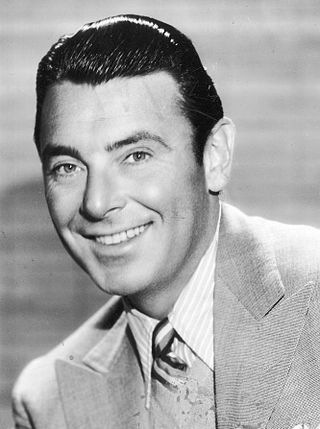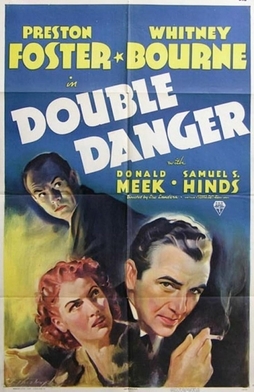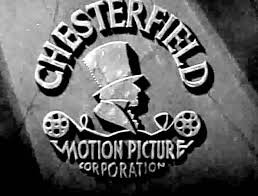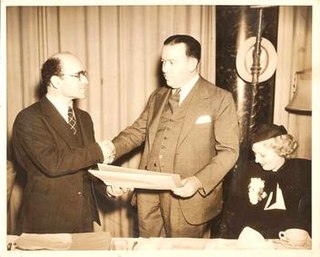Related Research Articles

Matthew Reginald Sheffield Cassan was an English-American actor.

George Brent was an Irish-American stage, film, and television actor. He is best remembered for the eleven films he made with Bette Davis, which included Jezebel and Dark Victory.

Producers Releasing Corporation was the smallest and least prestigious of the 11 Hollywood film companies of the 1940s. It was considered a prime example of what was called "Poverty Row": a low-rent stretch of Gower Street in Hollywood where shoestring film producers based their operations. However, PRC was more substantial than the usual independent companies that made only a few low-budget movies and then disappeared. PRC was an actual Hollywood studio – albeit the smallest – with its own production facilities and distribution network, and it even accepted imports from the UK. PRC lasted from 1939 to 1947, churning out low-budget B movies for the lower half of a double bill or the upper half of a neighborhood theater showing second-run films. The studio was originally located at 1440 N. Gower St. from 1936 to 1943. PRC then occupied the former Grand National Pictures physical plant at 7324 Santa Monica Blvd., from 1943 to 1947. This address is now an apartment complex.
Mascot Pictures Corporation was an American film company of the 1920s and 1930s, best known for producing and distributing film serials and B-westerns. Mascot was formed in 1927 by film producer Nat Levine. In 1935, it merged with several other companies to form Republic Pictures.
Pioneer Pictures, Inc. was a Hollywood motion picture company, most noted for its early commitment to making color films. Pioneer was initially affiliated with RKO Pictures, whose production facilities in Culver City, California were used by Pioneer, and who distributed Pioneer's films. Pioneer later merged with Selznick International Pictures.

Fred Astaire and Ginger Rogers were dance partners in a total of 10 films, nine of them released by RKO Radio Pictures from 1933 to 1939, and one, The Barkleys of Broadway, by Metro-Goldwyn-Mayer in 1949, their only film in Technicolor.

David O. Selznick (1902–1965) was an American motion picture producer whose work consists of three short subjects, 67 feature films, and one television production made between 1923 and 1957. He was the producer of the 1939 epic Gone with the Wind. Selznick was born in Pittsburgh and educated in public schools in Brooklyn and Manhattan. He began working in the film industry in New York while in his teens as an assistant to his father, jeweler-turned-film producer Lewis J. Selznick. In 1923, he began producing films himself, starting with two documentary shorts and then a minor feature, Roulette (1924). Moving to Hollywood in 1926, Selznick became employed at Metro-Goldwyn-Mayer (MGM), where he produced two films before switching to Paramount in early 1928. After helping to guide Paramount into the sound era, Selznick moved to RKO Radio in 1931 where he served as the studio's executive producer. During his time at RKO he oversaw the production of King Kong (1933) and helped to develop Katharine Hepburn and Myrna Loy into major film stars.
Lawrence J. Darmour (1895–1942) was an American film producer, operator of Larry Darmour Productions from 1927, and a significant figure in Hollywood's low-budget production community.
Grand Old Girl is a 1935 American drama film directed by John Robertson from a screenplay by Milton Krims, John Twist, Arthur T. Horman, adapted from a story by Wanda Tuchock. The film stars May Robson, Mary Carlisle, Fred MacMurray, and Alan Hale, other cast members included Ben Alexander.

Freckles is a 1935 American drama film directed by Edward Killy and William Hamilton from a screenplay written by Dorothy Yost, adapted by Mary Mayes from Gene Stratton-Porter's 1904 novel of the same name. Two earlier adaptations of Stratton-Porter's novel had been produced, the first by Paramount in 1917, and the second in 1928 by FBO, both were also titled Freckles. This 1935 version was released by RKO Radio Pictures on October 4, and stars Tom Brown, Virginia Weidler, and Carol Stone.

Double Danger is a 1938 American crime drama directed by Lew Landers, using a screenplay by Arthur T. Horman and J. Robert Bren based on Horman's story. The film stars Preston Foster and Whitney Bourne, with supporting roles by Donald Meek and Samuel S. Hinds. Produced by RKO Radio Pictures, it was released on January 28, 1938.
Charles R. Rogers, was an American film producer whose career spanned both the silent and sound film eras. Rogers began his career on the 1924 silent film, A Cafe in Cairo, produced by the short-lived Hunt Stromberg Productions. After Stromberg ceased productions in 1925, Rogers would found his own independent company, Charles R. Rogers Productions. He would also produce for major studios such as RKO Radio Pictures, Universal, and United Artists. The pinnacle of his career would be from 1936 to 1938 when he was chosen as the vice-president in charge of production for Universal Pictures. He died as the result of injuries sustained in a car accident in 1957.

Chesterfield Motion Picture Corporation, generally shortened to Chesterfield Pictures, was an American film production company of the 1920s and 1930s. The company head was George R. Batcheller, and the company worked in tandem with its sister studio, Invincible Pictures Corporation, which was led by Maury Cohen. The production company never owned its own studio and rented space at other studios, primarily Universal Pictures and RKO.

Cliff Reid, also known as George Clifford Reid, was an American film producer and film production studio founder during the 1930s and 1940s. In addition he also directed film shorts, and was the assistant director on several feature films.
George Nicholls Jr., also known as George Nichols Jr., was an American director and editor during the 1930s. Born to show business parents, and son of prolific actor and director George Nichols, he entered the film industry at the tail end of the silent film era, working as an editor for the Paramount Famous Lasky Corporation. After moving to RKO Pictures in 1933, Nicholls shortly began directing films by the end of the year. His career was cut short when he died in a car accident while driving to the location of his final film.
Arthur T. Horman was an American screenwriter whose career spanned from the 1930s to the end of the 1950s. During that time he wrote the stories or screenplays for over 60 films, as well as writing several pieces for television during the 1950s.

Samuel J. Briskin was one of the foremost producers of Hollywood's Golden Age, and head of production during his career at three of the "Big 8" major film studios: Columbia Pictures (twice), Paramount Pictures, and RKO Pictures. In the late 1950s, he was briefly on the board of directors of another major, Metro-Goldwyn-Mayer. During World War II, Briskin served in the army's Signal Corps as a film producer, attaining the rank of lieutenant colonel. After the war he co-founded Liberty Films with Frank Capra. They were later joined by William Wyler and George Stevens. The studio only produced two films, but both are now considered classics: It's a Wonderful Life and State of the Union. All three of his brothers were also film producers, as well as one of his sons, and his sister was married to the eventual Chairman of Columbia, where Briskin spent the last decade of his life as a vice-president and head of production until his death in 1968 from a heart attack.
William Stack was an American actor who began his acting career in Great Britain. Over the course of his career he appeared in over 50 films in the United States and United Kingdom, including such notable films as Mary of Scotland, Captains Courageous, and Gone with the Wind.
Lee Marcus, also known as Lee S. Marcus, was an American film producer of the 1930s and 1940s. During his fifteen-year career he produced over 85 films, most of them between 1934 and 1941 while he was at RKO Studios. Prior to his production career, Marcus worked for FBO and then RKO as a sales executive, reaching the level of vice president in both organizations. At RKO, he was head of production of the studio's b-films during the late 1930s and the beginning of the 1940s. He was also responsible for producing what many consider to be the first film noir, 1940's Stranger on the Third Floor.
George R. Batcheller (1892–1938) was an American film producer. He ran the low-budget studio Chesterfield Pictures in the 1930s.
References
- 1 2 Conlan, Mark Gabrish (April 16, 2012). "Forgotten (Chesterfield/Invincible/Universal, 1933)". Movie Magg. Retrieved September 6, 2015.
- ↑ "First Division to Get 12 More". The Film Bulletin. August 28, 1935. p. 7. Retrieved September 9, 2015.

- ↑ "Reach West Coast Today". Motion Picture Daily. November 18, 1933. p. 2. Retrieved September 9, 2015.

- 1 2 Parkinson, David (May 28, 2014). "A Crash Course In ... Poverty Row". MovieMail.com. Retrieved September 6, 2015.
- ↑ "Allied to Back Indie Producer". The Film Bulletin. May 27, 1936. p. 9. Retrieved September 9, 2015.

- ↑ "Things We Like for '36 - '37". The Film Bulletin. August 5, 1936. p. 1. Retrieved September 9, 2015.

- ↑ "To Work At Pathe". Motion Picture Daily. November 20, 1933. p. 8. Retrieved September 9, 2015.

- ↑ "To Work at Pathe". Motion Picture Daily. August 28, 1934. p. 10. Retrieved September 9, 2015.

- ↑ "The Economics of B Movies". Film Reference. Retrieved September 6, 2015.
- ↑ "Ready to Launch 18". Motion Picture Daily. August 22, 1934. p. 7. Retrieved September 9, 2015.

- ↑ "Cohen Out of Danger". Motion Picture Daily. March 26, 1935. p. 2. Retrieved September 9, 2015.

- ↑ "No Merger Intent". Motion Picture Daily. May 10, 1935. p. 2. Retrieved September 9, 2015.

- 1 2 "Report Maury Cohen Will Join Major Co". The Film Daily. December 28, 1936. p. 1. Retrieved September 6, 2015.

- ↑ "New York Tip-Off". The Film Bulletin. December 30, 1936. p. 4. Retrieved September 9, 2015.

- ↑ "New York Tip-Off". The Film Bulletin. January 6, 1937. p. 4. Retrieved September 6, 2015.

- ↑ "Maury Cohen Joins RKO as Producer". Motion Picture Daily. December 31, 1936. p. 1. Retrieved September 9, 2015.

- ↑ Balio, Tino (1995). Grand Design: Hollywood as a Modern Business Entertprise 1930-1939. University of California Press. p. 322.
- ↑ Wilk, Ralph (August 6, 1937). "A "Little" From Hollywood "Lots"". The Film Daily. p. 15. Retrieved September 6, 2015.

- ↑ "Maury Cohen to Quit". Motion Picture Daily. December 7, 1937. p. 5. Retrieved September 9, 2015.

- ↑ "Smith With Meglin-Fanchon". Motion Picture Herald. December 31, 1938. p. 70. Retrieved September 9, 2015.

- ↑ "Lesser to Concentrate on UA Deal, Breen to RKO; Wagner After Ford". Variety. March 29, 1939. p. 3. Retrieved September 9, 2015.

- ↑ "La Inmaculada". American Film Institute.
- ↑ "U.S. Bares 550 Witnesses for Trust Trial". Motion Picture Daily. March 7, 1940. p. 7. Retrieved September 9, 2015.

- 1 2 Thomas, Robert (August 24, 1944). "When Hollywood Shakes a Leg, It's Colossal!". Pottstown Mercury. p. 4. Retrieved August 9, 2015– via Newspapers.com.

- ↑ Rasmussen, Cecilia (October 7, 2007). "Palladium keeps in swing of things". Los Angeles Times. Retrieved August 9, 2015.
- 1 2 "Hollywood Palladium - 1940 - 1961". Go-Go Notes. January 1, 2009. Retrieved September 11, 2015.
- ↑ "Damnation Alley". American Film Institute.
{{cite web}}: Missing or empty|url=(help) - ↑ "Bonnie Key". Legacy.com. February 20, 2013. Retrieved September 6, 2015.
- ↑ "Maury M. Cohen filmography". American Film Institute. Retrieved September 12, 2015.